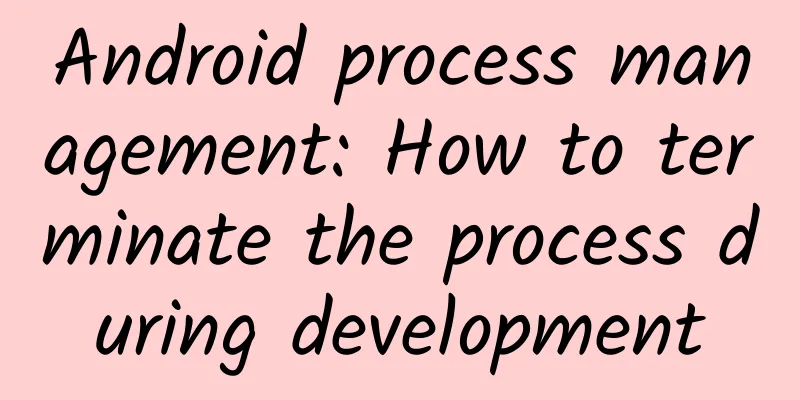Android process management: How to terminate the process during development

|
In Android, directly killing the application process is usually not a recommended practice, but sometimes you may need to kill the corresponding process for certain specific needs (such as debugging or managing applications).
or:
The Android system has its own strategy for managing processes and memory. If there is enough memory, Android will not kill any process at will; but if there is insufficient memory, the process may be killed at any time. When there is enough memory, Android will try to restore the previously killed process. For application developers, you should try to avoid relying on static variables to store important data, but should save the data to files or other persistent storage. At the same time, you also need to pay attention to the reasonable management of the application's memory usage to avoid the process being killed by the system due to problems such as memory leaks. |
>>: LinearLayoutCompat makes your Android linear layout more compatible, flexible and consistent
Recommend
Time is running out for Windows Phone to turn around
Microsoft has been particularly active recently, ...
SINOMACH Automobile: China's imported automobile market monthly report for January 2022
1. Supply After three years of decline, automobil...
WeChat's major update: Video accounts can now post 1-hour long videos
With the cheap price of traffic, video has become...
When charging, should you plug in the phone or the charger first? These incorrect charging methods will damage your phone quickly
For many people in modern society, how much batte...
Finally I experienced a good place to taste tea in Changsha. The old driver brought me here. It was really good after the experience. I would like to share it with you.
Changsha is a good place for tea tasting and drin...
The copy targeting is the same, why is the CTR still lower than others?
The copywriting is obviously very well written, s...
Why does the skin age?
Anti-aging can be said to be one of the mainstrea...
ZTE explains how to access the Internet on airplanes
Regarding the "Air China provides in-flight b...
Annoying phone battery life: It’s not the battery’s fault
The functions of the smartphones we use nowadays ...
This area of the United States has been extensively destroyed, and the culprit is actually the local "infrastructure maniac"?
From the perspective of biodiversity, the Arctic ...
The entire process of a new APP from establishment to acquiring users!
In the early stages of entrepreneurship , from bu...
The song "Black Plum Sauce" made popular by Li Ronghao actually doesn't exist?
Review expert: Shi Jun, Ph.D. in Botany "......
Console-exclusive games are coming to PC. Where will TV games go?
Recently, there have been media reports that the ...
How should SEM bidders deal with the setbacks they may encounter in their work?
As an SEM person, you will encounter various prob...
Why is Sichuan pepper so spicy?
Spicy and spicy. Spicy and spicy are always assoc...



![[Recommended by Zhihu] Those Android development tools that you can’t stop using](/upload/images/67ebe8a2e11b5.webp)




![[Smart Farmers] Why the beautiful Canada goldenrod became the "devil's flower"](/upload/images/67f2536e43c0e.webp)
